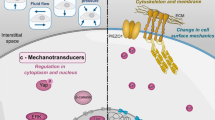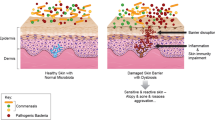Summary
A new culture medium, NCTC 168, has been designed for human skin epithelial cells. This medium formulation was developed, by combining and testing at various concentrations, components of media NCTC 135 and 163, since a 1∶1 mixture of these two media with 10% horse serum supplement was found to promote epithelial cell outgrowth from human skin explants. The buffer system in NCTC 168 maintains the pH of the medium between 7.0 and 7.2. In contrast to other media tested, NCTC 168 with 10% horse serum is capable of initiating and sustaining larger epithelial cell outgrowths. Explants in serum-supplemented NCTC 168 in the absence of feeder cells reproducibly yield confluent epithelial cell sheets apparently free of fibroblasts after only 19 to 28 days as compared with 5 weeks or longer for the other media tested. NCTC 168 also supports passage of human epithelial cells to the sixth subculture generation without feeder cells. Electron microscopy has shown the presence of desmosomes and tonofilaments in the passaged cells indicating the epithelial nature of the cells. The addition of epithelial growth factor, hydrocortisone and insulin at 5 ng per ml, 4 μg per ml and 5 μg per ml, respectively did not appreciably enhance the growth of the epithelial cells.
Similar content being viewed by others
References
Gey, G. O., W. D. Coffman, and M. T. Kubicek. 1952. Tissue culture studies of the proliferative capacity of cervical carcinoma and normal epithelium. Cancer Res. 12:264–265.
Moore, A. E., L. Sabachewsky, and H. W. Toolan. 1955. Culture characteristics of four permanent lines of human cancer cells. Cancer Res. 15: 598–602.
Moore, G. E., and A. A. Sandberg. 1964. Studies of a human tumor cell line with a diploid karyotype. Cancer 17:170–175.
Giard, D. J., S. A. Aaronson, G. J. Todaro, P. Arnstein, J. H. Kersey, H. Dosik, W. P. Parks. 1973.In vitro cultivation of human tumors. Establishment of cell lines derived from a series of solid tumors. J. Natl. Cancer Inst. 51: 1417–1423.
Rheinwald, J. G., and H. Green. 1975. Serial cultivation of strains of human epidermal keratinocytes: the formation of keratinizing colonies from single cells. Cell 66:331–344.
Steinberg, M. L., and V. Defendi. 1979. Altered pattern of growth and differentiation in human keratinocytes infected by Simian virus 40. Proc. Natl. Acad. Sci. 76:801–805.
Fox, C. H., J. K. Selkirk, F. M. Price, R. G. Croy, K. K. Sanford, and M. Cottler-Fox. 1975. Metabolism of benzo(a)pyrene by human epithelial cells. Cancer Res. 35:3551–3557.
Evans, V. J., J. C. Bryant, H. A. Kerr, and E. L. Schilling. 1964. Chemically defined media for the cultivation of long-term cell strains from four mammalian species. Exp. Cell Res. 36:439–474.
Price, F. M., and V. J. Evans. 1976 Preparation of medium NCTC 163. Procedure 35714. TCA Manual 3:497–501.
Madin, S. H., and N. B. Darby, Jr. 1958. Established kidney cell lines of normal adult and bovine origin. Proc. Soc. Exp. Biol. Med. 98: 574–576.
Coon, H. G., 1966. Clonal stability and phenotypic expression of chick cartilage cellsin vitro. Proc. Natl. Acad. Sci. 55:66–73.
Setaro, F., and G. G. Morley. 1976. A modified fluorometric method for the determination of microgram quantities of DNA from cell or tissue cultures. Anal. Biochem. 71:313–317.
Mollenhauer, H. H. 1964. Plastic embedding media for use in electron microscopy. Stain Technology 39:111–114.
Richter, A., K. K. Sanford, and V. J. Evans. 1972. Influence of oxygen and culture, media on plating efficiency of some mammalian tissue cells. J. Natl. Cancer Inst. 49:1705–1712.
Morton, H. J. 1970. A survey of commercially available tissue culture media. In Vitro 6: 89–108.
Price, F. M., J. Rotherham, and V. J. Evans. 1970. Some aspects of the role of vitamin B12 in the nucleic acid synthesis in a neoplastic C3H mouse cell strain. I. Growth studies. J. Natl. Cancer Inst. 44:85–90.
Perry, V. P., V. J. Evans, W. R. Earle, G. W. Hyatt, and W. C. Bedell. 1956. Long-term tissue culture of human skin. Am. J. of Hygiene 63:52–58.
Green, H. 1977. Terminal differentiation of cultivated human epidermal cells. Cell 11:405–416.
Flaxman, B. A., M. A. Lutzner, and E. J. Van Scott. 1967. Cell maturation and tissue organization in epithelial outgrowths from skin and buccal mucosain vitro. J. Invest. Dermatol. 49:322–334.
Sun, T., and H. Green. 1976. Differentiation of the epidermal keratinocyte in cell culture: Formation of the cornifier envelope. Cell 9:511–521.
Werrlein, R. J., and A. D. Glinos. 1974. Oxygen microenvironment and respiratory oscillations in cultured mammalian cells. Nature 251:317–318.
Taylor, W. G., R. F. Camalier, and K. K. Sanford. 1978. Density-dependent effects of oxygen on the growth of mammalian fibroblasts in culture. J. Cell Physiol. 95:33–40.
Andresen, W. F., F. M. Price, J. L. Jackson, T. B. Dunn, and V. J. Evans. 1967. Characterization and spontaneous neoplastic transformation of mouse embryo cells isolated and continuously culturedin vitro in chemically defined medium NCTC 135. J. Natl. Cancer Inst. 38:169–183.
Evans, V. J., and K. K. Sanford. 1978. Development of defined media for studies on malignant transformation in culture. In: H. Katsuta (Ed.),Nutritional Requirements of Cultured Cells. Japan Scientific Societies Press, Tokyo, and University Park Press, Baltimore, pp. 149–194.
Evans, V. J., J. C. Bryant, M. C. Fioramonti, W. T. McQuilkin, K. K. Sanford, and W. R. Earle. 1956. Studies of nutrient media for tissue cellsin vitro. I. A protein-free chemically defined medium for cultivation of strain L cells. Cancer Res. 16:77–86.
Karasek, M. A. 1966.In vitro culture of human skin epithelial cells. J. Invest. Dermatol. 47: 533–540.
Waymouth, C. 1970. Osmolality of mammalian blood and of media for culture of mammalian cells. In Vitro 6:109–127.
Sanford, K. K., B. B. Westfall M. C. Fioramonti, W. T. McQuilkin, J. C. Bryant, E. V. Peppers, V. J. Evans, and W. R. Earle. 1955. The effect of horse serum residue and chemically defined supplements on proliferation of strain L mouse cellsin vitro. J. Natl. Cancer Inst. 16:789–802.
Boone, C. W. 1973. A surveillance procedure applied to sera. In: E. F. Kruse, Jr., and M. K. Patterson, Jr. (Eds.),Tissue Culture Methods and Applications. Academic Press pp. 677–682.
Fox, C. H., and K. K. Sanford. 1975. Chemical analysis of mammalian sera commonly used as supplements for tissue culture media. Procedure 94121. TCA Manua. 4:233–237.
Author information
Authors and Affiliations
Rights and permissions
About this article
Cite this article
Price, F.M., Camalier, R.F., Gantt, R. et al. A new culture medium for human skin epithelial cells. In Vitro 16, 147–158 (1980). https://doi.org/10.1007/BF02831505
Received:
Accepted:
Issue Date:
DOI: https://doi.org/10.1007/BF02831505




